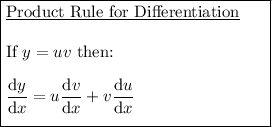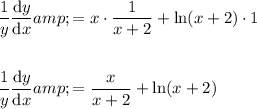Answer:
![\textsf{A.} \quad (2+x)^x\left[(x)/(2+x)+\ln(2+x)\right]](https://img.qammunity.org/2024/formulas/mathematics/college/8bjbdhjxxb7o4xm17ncpjwm9ifcfpuodky.png)
Explanation:
Replace f(x) with y in the given function:

Take natural logs of both sides of the equation:



Differentiate using implicit differentiation.
Place d/dx in front of each term of the equation:

First, use the chain rule to differentiate terms in y only.
In practice, this means differentiate with respect to y, and place dy/dx at the end:

Now use the product rule to differentiate the terms in x (the right side of the equation).



Therefore:

Multiply both sides of the equation by y:

Substitute back in the expression for y:

Therefore, the differentiated function is:
![f'(x)=(x+2)^x\left[(x)/(x+2)+\ln(x+2)\right]](https://img.qammunity.org/2024/formulas/mathematics/college/dpi84um8t2rkcr95p8b0c4qt8zu669pudq.png)
![f'(x)=(2+x)^x\left[(x)/(2+x)+\ln(2+x)\right]](https://img.qammunity.org/2024/formulas/mathematics/college/z4odbu52gt7clca5oqu49aith6qhh1wzl5.png)